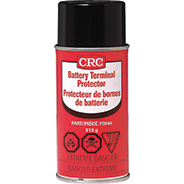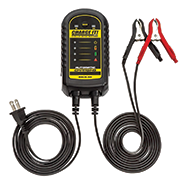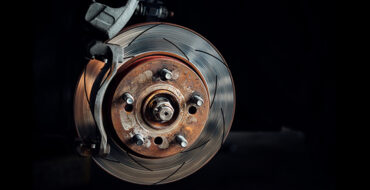Not all car batteries suit all vehicles. Let’s go over some common types of car batteries, how to choose the right one for your vehicle, how often to replace your battery, and some tips for maintaining this essential part of your vehicle.
How to Choose a Car Battery

Types of Car Batteries
Some of the most common types of car batteries are lead-acid, lithium-ion, AGM, and deep cycle.
Lead-Acid
Lead-acid batteries are the oldest and most common type of car battery. They come in several types, of which SLI (starting, lighting, and ignition) batteries are one of the most popular kinds, and use a sulfuric acid solution as an electrolyte to power your car. Lead-acid batteries are the go-to option for passenger vehicles because of their affordable price and simple installation process.
AGM
Absorbent glass mat (AGM) batteries are spill-proof sealed lead-acid batteries. They contain special glass mats coated in acid that hold the battery’s electrolyte in place. AGM batteries often last longer than standard lead-acid batteries, but they’re more expensive. If you live in an extremely hot or cold climate, an AGM battery is worth considering. Compared to lead-acid batteries, AGM batteries are better equipped to handle extreme temperatures.
You can upgrade from a lead-acid battery to an AGM one, but you can’t downgrade to a lead-acid battery if your vehicle came with an AGM battery from the factory.
Lithium-Ion
Almost all electric vehicles use lithium-ion batteries. Positively charged lithium ions travel from the cathode to the anode and vice versa to create a current of electricity. Lithium-ion batteries last longer and charge faster than lead-acid batteries, but they’re double the price.
Deep Cycle
Deep cycle batteries can use lithium-ion or lead-acid technologies. They’re much more powerful than other batteries, so you likely won’t need one to power a daily-use vehicle long term. They can be useful for a jumpstart, but they’re mainly meant for RVs, trolling motors, or boats. You can read more about deep cycle batteries here.
Choosing a Car Battery
Aside from the battery type, you need to choose the right battery size for your vehicle. A battery group size refers to the physical size of the battery and its polarity (where the positive and negative battery posts are located). The most common car battery group sizes are 24, 24F, 25, 34, 35, 51, 51R, 52, 58, 58R, 59, and 65.
Your owner’s manual should list the battery size you need. If you don’t have a physical copy of your manual, look online for a digital version. You can also use your current battery as a reference for what size to select.
Another thing you need to consider is your vehicle’s Cold Cranking Amperage (CCA). This is the minimum amount of power your vehicle needs to start. If you choose a battery below your vehicle’s CCA, you’ll have trouble getting out of your driveway. You can find your vehicle’s CCA on your existing battery or in your owner’s manual.
We have a wide selection of car batteries on NAPAcanada.com and in our stores. If you input your vehicle details in the top left corner of the website, you’ll be matched with batteries guaranteed to fit.
Remember to drop off your old battery at a collection site or a NAPA Auto Parts store to be recycled. Don’t dispose of it with your regular garbage. This is dangerous.
How Often Should You Replace Your Car Battery?
No matter how well you care for your car, certain parts will need to be replaced eventually. You should replace your car’s battery, for example, at least once every three to five years.
Near the end of your battery’s life, you may notice the following symptoms:
- dim headlights
- slow engine crank
- vehicle dies quickly after starting
- battery warning light is on
You can try recharging your battery first before replacing it. If your battery appears swollen, cracked, corroded, or is leaking, do not recharge it. Instead, jump straight to a battery replacement.
Follow this guide to learn how to do a car battery replacement from your own garage. Remember to always use the right tools and proper safety equipment when working on any part of your vehicle.
Battery Maintenance
Whatever type of car battery you have, maintaining it with regular cleaning will help it last as long as possible. Use the following products once every four to six months to keep your battery and its terminals clean:
Other useful battery-related items to keep in your garage and/or trunk include:
For more battery maintenance tips, check out this article.
If you have any questions about choosing or maintaining your car battery, visit a NAPA Auto Parts store for some expert advice.





